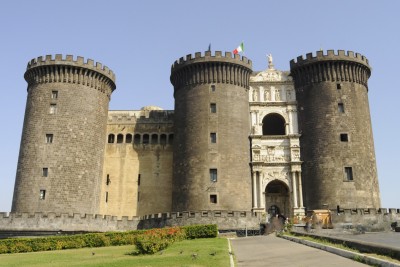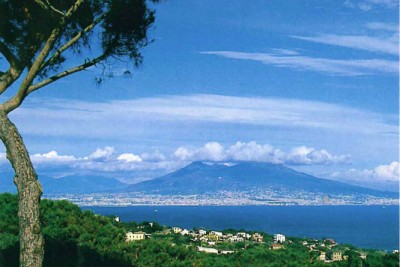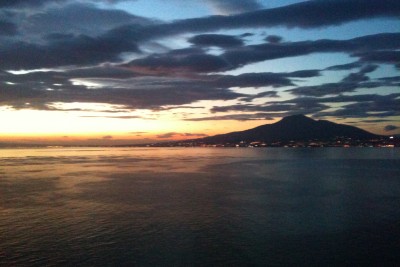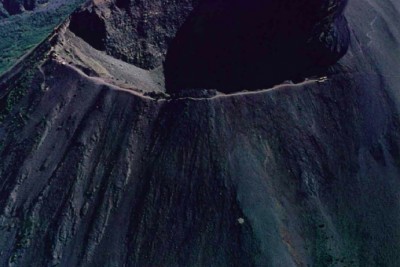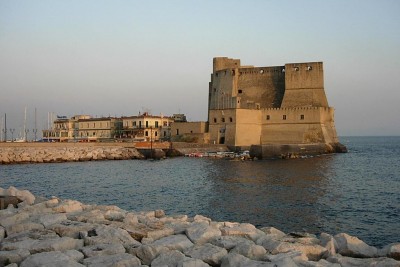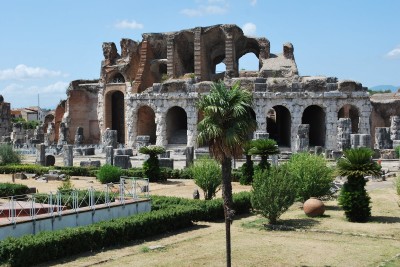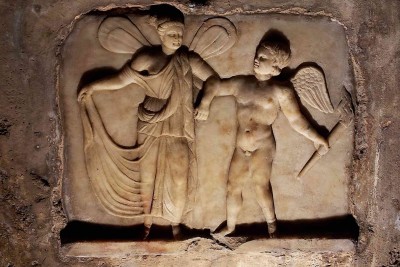Our Insider Guide to Naples - Part 2
Even with all its difficulties and contradictions Naples remains an extraordinary place to visit



From Castel Nuovo to Foria and the Sanità
The area along via Toledo, includes some of the most important monuments of the City: the Maschio Angioino, the Royal Palace, piazza del Plebiscito, the San Carlo Theater, the Umberto I Gallery, the National Archaeological Museum.
Castel Nuovo (named so as to distinguish it from the older royal residences - Castel dell'Ovo and Castel Capuano) is also known as Maschio Angioino (#23).
 Castel Nuovo
Castel Nuovo
It is an impressive fortress begun in 1279 by Charles I of Anjou. It has a trapezoid base and is surrounded by a moat where the foundations of the five cylindrical towers stand.

The Triumph Arch marks the entrance to the castle and is its main ornament. It was erected to commemorate the triumphal entrance to the city by Alfonso of Aragon in 1443. Its sculpted reliefs represent the finest examples of Renaissance sculpture in the south.
The Museo Civico here was inaugurated in 1992 (open Mon. – Sat. from 9:00 a.m. to 7.00 p.m.; Sundays 9:00 a.m. to 2:00 p.m.; closed on January 1st and December 25th). The Museum includes the "Hall of the Barons"; the "Sala Maggiore", the isetting for royal audiences in the 14th century, completed with frescoes by Giotto, and characterized by the 30-foot high vaulted dome; the "Picture Gallery", with mostly religious works from the 15th to 18th centuries on the first floor, and works from the 18th to 20th centuries, including a collection of 19th century Neapolitan paintings, on the second one; the "Palatine Chapel", which reveals the remains of a cycle of frescoes by Giotto and his school; the "Chapel of the Souls in Purgatory", whose interiors has Baroque decorations; the "Chapel of St. Francesco di Paola", decorated in the Baroque style.
Castel Nuovo dominates the center of piazza Municipio. At the high end of the square is the Palazzo San Giacomo (#24).

Palazzo San Giacomo
This palace was built by King Ferdinand I of Bourbon adjacent to the fortress of the Castel Nuovo as a central block of offices for the ministries of his government. It is now the municipio or City Hall of Naples.
The complex incorporates the 16th century Church of San Giacomo degli Spagnoli. The original church was commissioned in 1540 by the Spanish viceroy Don Pedro Álvarez de Toledo and dedicated to St James, the patron saint of Spain.
The interior still retains a number of monumental tombs, including for the viceroy Don Pedro de Toledo, his wife and son, sculpted in 1570 by Giovanni da Nola.
Near the entrance are two sculptures by Francesco Cassano. In addition the tomb of Ferdinando Maiorca and his wife Porzia Coniglia in the apse was completed by Michelangelo Naccherino.
The nearby Galleria Umberto I (#25) was built between 1887 and 1890.
 Galleria Umberto I
Galleria Umberto I
Designed by Emanuele Rocco, who employed modern architectural elements reminiscent of the Galleria Vittorio Emanuele II in Milan, it was a cornerstone in the decades-long rebuilding of Naples called the risanamento. I
It was named for Umberto I, who was King of Italy at the time of construction.
It was meant to combine businesses, shops, cafes and social life — public space — with private space in the apartments on the third floor.
The Galleria is a high and spacious cross-shaped affair surmounted by a glass dome braced by 16 metal ribs.
Of the four glass-vaulted wings, one fronts on via Toledo (via Roma), still the main downtown thoroughfare, and another opens onto the San Carlo Theater.
It has returned to being an active center of Neapolitan civic life after years of decay.
A few doors down from one of the entrances to the Galleria, is the Chiesa di Santa Brigida (#26).

Chiesa di Santa Brigida
The origins date to 1609 but the church was expanded during 1637-1640.
Because of its location near the Castel Nuovo, the Spanish authorities demanded that the church only have a low dome, which would not block the view from gunners in the Castle.
The interior, in Latin cross, displays Baroque-style pictorial cycles: Glory of Santa Brigida, St Nicola, The Last Judgment and The Passion, by Luca Giordano. The painter himself is buried in the church.
Some of the Giordano paintings were completed by his pupil, Giuseppe Simonelli.
Other painters active in the church include Massimo Stanzione and Paolo De Matteis.
The dome has an artificial vanishing point painted by Giordano, which makes it look more slender.
It has a beautiful fresco called Heaven, by Luca Giordano, in its dome.
The Teatro San Carlo (#27), inaugurated on November 4, 1737, is the oldest opera house in the world.
 The interior of the San Carlo
The interior of the San Carlo
It was commissioned by the Bourbon King Charles VII of Naples, who wanted to endow Naples with a new and larger theater that would replace the smaller Teatro San Bartolomeo, which had served the city well, becoming an important opera center.
Designed by Giovanni Antonio Medrano, a military architect, and Angelo Carasale, the former director of the San Bartolomeo, the San Carlo was inaugurated on 4 November 1737.
Much admired for its architecture, its gold decorations, and the sumptuous blue upholstery (blue and gold being the official colors of the Bourbons), the San Carlo was at the time the biggest opera house in the world.
Partially destroyed by fire in 1816, it was restored by Antonio Niccolini, the designer of its façade.
In the early 1800's the theater lived through one of its most glorious seasons ever thanks to the impresario Domenico Barbaja who commissioned works by musicians such as Gioachino Rossini and Gaetano Donizetti.
Coming out of the theater you are on piazza Trieste e Trento (once piazza San Ferdinanda) where the historical cafe Gambrinus still stands, once the preferred meeting place for poets and intellectuals.
The baroque Chiesa di San Ferdinando (#28) gives onto the same square.
 Chiesa di San Ferdinando
Chiesa di San Ferdinando
It was originally dedicated by the Jesuits to St Francis Xavier and built in 1636.
In 1767, with the expulsion of the Jesuits from the Kingdom of Naples, the church was granted to the Padri Costantiniani who dedicated the church to St Ferdinand in honor of the Neapolitan King.
The counterfacade has a fresco with the story of St Francis Xavier and other Jesuits by Paolo De Matteis.
The church contains statues by Domenico Antonio Vaccaro and Giuseppe Sanmartino. The main altarpiece is a canvas depicting San Ferdinando by Federico Maldarelli.
The church is home to a great tradition: every Good Friday the Stabat Mater of Pergolesi is performed.
Crossing the piazza Trieste e Trento the famous piazza del Plebiscito (#29) opens up.
 Piazza Plebiscito
Piazza Plebiscito
It is the largest of the city, spectacular backdrop of cultural events and concerts.
The piazza is defined by the Chiesa di San Francesco di Paola (#30), with its neoclassical colonnade and an interior inspired by the Pantheon of Rome.

San Francesco di Paola
The façade is fronted by a portico resting on six columns and two Ionic pillars.
Inside, the church is circular with two side chapels.
The dome is 53 metres high.
The interior has a number of statues.
In the chapels on the right, there are a series of altarpieces, including a San Nicola da Tolentino and a St Francis of Paola receiving a stem of charity from an Angel, by Nicola Carta, and a Final Communion of San Ferdinando di Castiglia by Pietro Benvenuti.
In the apse is a painting of St Francis of Paola resuscitating a dead man by Vincenzo Camuccini.
In the sacristy is an Immaculate Conception by Gaspare Landi and a Circumcision of Jesus by Antonio Campi.
At the center of the square the two great statues of Charles of Bourbon (work of Antonio Canova) and Ferdinand I on horseback face the Royal Palace.
Located in Piazza del Plebiscito (which was once known as Largo di Palazzo) and built in the year 1600, the Palazzo Reale (#31), or Royal Palace, was passed to the Bourbons and to the Savoys, and finally to the State of Italy in 1946.
 Palazzo Reale
Palazzo Reale
Spanish Viceroy Fernando Ruiz de Castro hired the architect Domenico Fontana (1543-1607) to build the palace in late Renaissance style.
The original structure was expanded a century later when the "New Wing" was ordered by Carlos of Bourbon.
The newer part of the palazzo is an L-shaped structure looking towards the Castel Nuovo.
After a fire in 1837, Ferdinand Bourbon II arranged for a large renovation project lead by architect Gaetano Genovese which enlarged the older building and unified the space stylistically.
Standing at the fountain, you can admire the long Mannerist façade and the archways which were partially closed in 1888 by King Umberto the First. King Ferdinand arranged for eight statues of prominent rulers to be displayed in these niches.
The statues were of previous Kings of Naples: Roger II of Sicily (or Roger the Norman); Frederick II of Swabia; Charles I of Anjou; Alfonso V of Aragon; Charles V; Charles III of Spain; Gioacchino Murat and Vittorio Emanuele III of Savoy.
The gardens have been maintained by the rulers of Naples ever since the construction of the New Castle (Castelnuovo) at the end of the 13th century.
They were later restored with the addition of small lanes, statues and an iron gate with gilded spears.
Since 1926, this gate has opened directly in front of Castel Nuovo, whose entrance on this side is marked by the iron statue of Palafrenieri (commonly called “bronze horses”).The statue is by Baron Clodt von Jurgenburg and was donated by Czar Nicolas I to Ferdinand II in honor of his visit in 1845.
In the back of the gardens there is a ramp that leads to the 19th century stables, which are currently being used as an exposition space.
To visit the interior cross over the honor courtyard and enter the Historical Living Quarters Museum (30 rooms on one floor) which has preserved the original furniture and decor.
The monumental staircase of colored marble inlay and the Small Court Theater, a ballroom transformed in 1768 by Fernando Fuga into a gracious Rococo ambience, are beautiful.
In another part of the Palace is the National Library, the Biblioteca Nazionale Vittorio Emanuele III (#32).
 Biblioteca Nazionale Vittorio Emanuele III
Biblioteca Nazionale Vittorio Emanuele III
With more than a million and a half volumes and several priceless medieval codices, the library was founded at the end of the 18th century in the Palazzo degli Studi (which now houses the Museo Archeologico).
In 1910 the Officina dei papiri ercolanensi, the workshop founded by Charles of Bourbon to conserve the papyri found in excavations at Herculaneum – was added to the library.
After long debate and on the suggestion and efforts of philosopher Benedetto Croce, in 1922 the library was moved to its present location at Palazzo Reale, granted to the library by King Victor Emmanuel III (whose name it still bears).
Off to one side of via Toledo, at the foot of the San Martino Hill, the spider web of alleys and tight streets of the Quartieri Spagnoli, or Spanish Quarters, unfolds (#33).
 View of the Quartieri Spagnoli
View of the Quartieri Spagnoli
Once in piazza Carità, a little detour must be made to visit two jewels of Renaissance art: the Church of Sant'Anna dei Lombardi and the Church of Santa Maria La Nova.
Built in the 1400's, the Chiesa di Sant'Anna dei Lombardi (#34), also known as the Church of Monteoliveto, preserves its simple interior and the rigorous formality of the original structure.
 Sant'Anna dei Lombardi
Sant'Anna dei Lombardi
The original church was built in 1411. Further work was done first in 1581 by Domenico Fontana and then in the 17th century,when the church and the convent were reconstructed in a Baroque style by Gaetano Sacco.
At one time it was one of the largest monasteries in Italy, occupying what today can be measured only in "city blocks".
The Del Pezza and Ligorio altars are masterpieces of Renaissance sculpture.
The magnificent life-size terracotta sculptures of the Lament of the Dead Christ (said to represent the members of the Aragon royal family) are hosted in the capital area.
The Renaissance Chiesa di Santa Maria la Nova (#35) is known for its imposing cloisters.
 Chiesa di Santa Maria la Nova
Chiesa di Santa Maria la Nova
In the early 13th century a Franciscan monastery, named Santa Maria ad Palatium, had existed nearby, but it was demolished in order for Charles of Anjou to build the Castel Nuovo, or Maschio Angioino.
By 1279, the Friars were granted this site to build a new church, hence la Nova (the New One).
Initially constructed in Gothic style, the building was battered by Naple's frequent earthquakes and suffered gravely from an explosion originating from Castel Sant'Elmo on December 13, 1587.
This last episode prompted reconstruction in 1596-1599, as announced in a cornice inscription, leading to the facade we see today, designed by Agnolo Franco.
The church nave ceiling is decorated with 46 gilt-framed cassetone, or rectangular fresco panels, painted by the major Neapolitan artists of the day.
The third chapel on the left, the largest in the church, is called the Cappellone di San Giacomo della Marca. Its ceilings are frescoed by Massimo Stanzione, and depict the Miracles of the Saint, including the procession by Neapolitans with his body to compel the volcano Vesuvius to stop its 1631 eruption.
The seventh chapel on the left, partially obstructed by the organ, has paintings attributed to an 8 year old Luca Giordano.
The last part of via Toledo gives onto piazza Dante (#36), with its statue of Dante by Tito Angelini (1872).
 Piazza Dante
Piazza Dante
The square assumed its present structure in the second half of the 18th century, with the intervention of the architect Luigi Vanvitelli, who added the Foro Carolino, a commemorative monument to King Charles III of Bourbon.
The work lasted from 1757 to 1765, and the result was a big semicircle, along the Aragonese walls, which embraced Port'Alba and the church of San Michele.
On top of the building, with its two wings curved features, are twenty-six statues representing the virtues of Charles.
In the center a niche was supposed to accommodate an equestrian statue the sovereign, but was never built. Port'Alba stands out to the left of the hemicycle. From there you reach the street by the same name, site of some of the oldest bookstores of Naples.
The nearby Museo Archeologico Nazionale (#37), opened by Charles of Bourbon, is the most important museum of classical archaeology in the world.

Mosaic from Pompeeii
The most important collection of the museum is that of the mosaics, paintings, jewelry and objects recovered from the buried Vesuvian homes.
Another highlight is the classical sculpture collection, with Roman copies of Greek originals and the celebrated Farnese sculptures (the Bull, the Hercules and dozens of others).
The cameo and cut gem collection, which includes the extraordinary Farnese Cup, is also very rich.
The vast epigraph collection includes over 2,000 pieces representing all of the languages once spoken in Campania (from Greek to Oscan, Etruscan to Latin).
The Egyptian collection is only second in importance in Italy to that of Turin.
There is a section dedicated to the Papyrus Villa, the famous roman house in Herculaneum that brought to light so many relics, amongst which the celebrated statues in bronze and marble.
The Secret Cabinet is the part of the museum that houses a 19th century collection of Greek and Roman objects considered "obscene" at the times, reserved only for authorized visitors. It includes now sculptures, frescoes, mosaics, amulets, oil-lamps and graffiti with erotic themes from the digs at Pompeii.
From the museum you get onto piazza Cavour, where via Faria begins, a road that crosses the popular Sanità, Vergini and Sant'Antonio districts.
The lovely 16th century Chiesa di Santa Maria della Sanità (#38) was originally attached to a Dominican monastery founded in 1577.

Santa Maria della Sanità
It was built from 1602 to 1613 in a centralized Greek-cross plan using the architectural designs of Giuseppe Nuvolo.
The main altar is elevated and accessed via flanking Baroque-style spiraling staircases, all sheathed polychrome marble.
Luca Giordano painted a “San Nicola with Saints Ambrogio and Ludovico Beltrando” in the right first chapel, a “San Vincenzo” in the third chapel on the right, and “Virgin with St. Rose” in second chapel on the left.
From the church you gain access to the Catacombs of San Gaudioso.
The entrance to the catacombs is beneath the altar, which was elevated above the site of the original chapel at the site.
In this neighborhood you can find the 17th century Palazzo dello Spagnolo (#39)
 Palazzo dello Spagnolo
Palazzo dello Spagnolo
Through an indistinct façade, you enter to an interior octagonal courtyard that leads to a unique double ramp stairwell.
The top floor was added at the end of the 18th century. In the following century, the family sold apartments in the lower floors to Tommaso Atienza, nicknamed lo Spagnolo (the Spaniard), from whence the name of the palace.
The staircases with arches in shifting planes still grants an aura of complex scenography, despite its present cramped and dilapidated state.
The nearby Palazzo San Felice is attributed to the same architect and has similar staircases.
Further along, via Faria reaches the Botanical Gardens. Created in 1807 by Giuseppe Bonaparte, they were originally conceived to study plants useful to agriculture, commerce and for medicinal purposes.
Today, the area of circa 25 acres contains about 10,000 species for a total of 25,000 plants, one of Italy's most important collections for content and area.
Back at the Archaeological Museum, going towards Capodimonte on via Santa Teresa degli Scalzi, next to the big Church of Incoronata del Buon Consiglio are the Catacombe di San Gennaro (#40), among the oldest and most amazing of Campania.

Catacombe di San Gennaro
They originally were three separate cemeteries, dedicated, respectively, to Saint Gaudiosus, Saint Severus and St. Januarius, or San Gennaro, the patron saint of the city.
There are different from their Roman counterparts in that they have more spacious passageways along two levels.
The lower level is the oldest, going back to the 3rd-4th century and may actually be the site of an earlier pre-Christian cemetery.
The second level was the one expanded so as to encompass the other two adjacent cemeteries.
The site was consecrated to San Gennaro in the 5th century on the occasion of the entombment of his remains, which were later moved to the Cathedral of Naples.
Until the 11th century the catacombs were the burial site of Neapolitan bishops. Between the 13th and 18th century, they were subjected to severe looting.
Going further up the hill you arrive at the Palazzo Reale e Museo di Capodimonte (#41), or Royal Palace and Museum of Capodimonte, which houses the museum by the same name (see description in Part 3).

Palazzo Reale e Museo di Capodimonte
For printing our entire Naples Guide (facing pages) you can download the PDF by clicking HERE
For offline reading on your smartphone or tablet, you can download the PDF of our entire Naples Guide (single page) by clicking HERE. If you have an Android OS, you will find it in your Download app. If you have an iPhone or an iPad, open and save it in iBook (free app).
Watch a video on Naples

